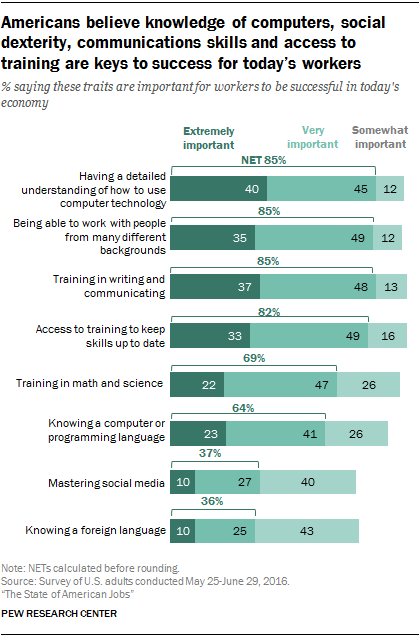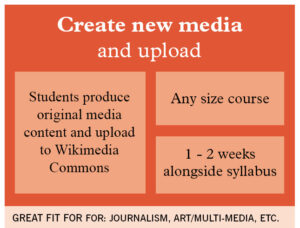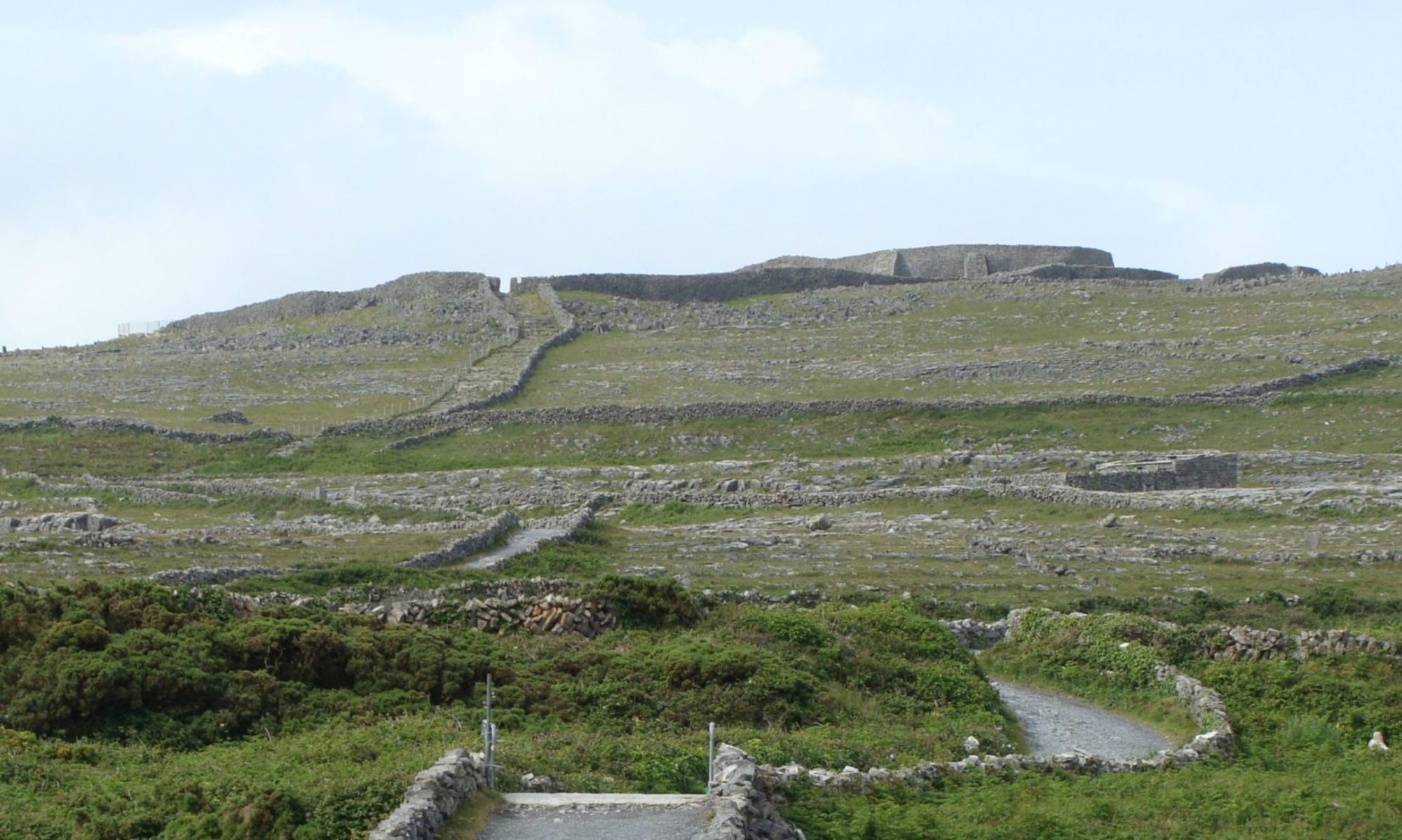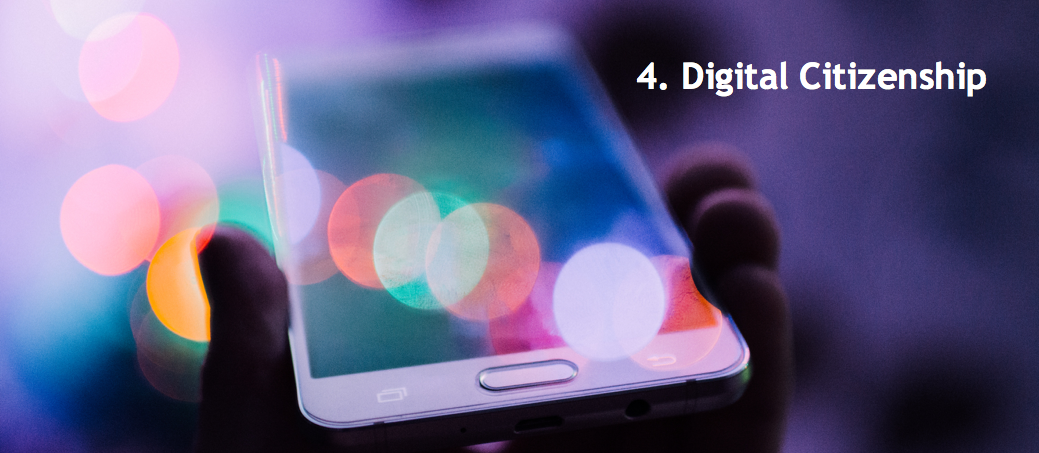“In the connected era, students will be most successful after college if they have a digital presence that promotes their unique abilities and strengths. Online instructors are poised to play a powerful role in the development of our students’ digital footprint. Students aspire to be like their instructors who actively model safe and professional use of digital tools and resources. Effective online teachers understand that engaging students in the web is an important part of becoming digitally literate and, as such, learning is not tied to a textbook”. – @One
How will I ask my students to interact with digital environments differently?
I am looking forward to having my students be more proactive with the creation of content outside the LMS. Having them connect with leaders in their field via social media channels such as Twitter will help them build their professional network. Adding content to Wikimedia Commons (see example below) or curating a Pinterest feed with infographics or data sets found on their research topic will give them a sense of ownership and expertise that they can share with the class. These learning tools help our students become active participants in their fields of study. They can also ignite further interest and study and teach students about personal learning networks.

In their 21st century professional lives, students will effortlessly communicate via social media tools. They will quickly switch between Adobe and Microsoft products, Wordpress and other blog-type platforms (i.e. Medium, Ghost). They will easily maneuver through SQL databases, enterprise software and the proprietary applications of their chosen profession. They will understand that to be successful, they must acknowledge the importance of lifelong learning and be in constant learning mode for all the new tools to be introduced in years to come.
According to The Pew Research Center, the top three traits that are ranked as "very or extremely important" for employment are understanding computer technology, being able to work with people of different backgrounds, and training in writing and communicating.
Participatory learning in education will prepare our students to excel in these areas. In many respects, they have already grasped the importance of engagement via social media and even through gaming and fan sites. Organizational researcher John Seely Brown, sees the gaming disposition of young people as the catalyst to embracing change. “If I ain’t learning, it ain’t fun” says Seely Brown of their growth mindset. This attitude is positively affecting their outlook on life.
Digital Citizenship: Some Examples
Introducing non-disposable assignments
Having students create, share and continually curate content beyond the classroom is something I want to pursue in my teaching practice. According to Pacansky-Brock, a non-disposable assignment is “work a student produces that has a life beyond the end of the class” (2017, p. 149). By definition, the work resides outside the LMS where it would otherwise be locked down never to see the light of day once the course ended. When the assignment becomes part of a student’s ePortfolio or a blog or a personal website, it increases a student’s motivation and sense of creating something for the greater good and it adds value and promotes digital literacy. In essence, “you are providing opportunities for students to apply what they are learning inside the digital classroom to authentic environments outside the digital classroom” (@One Digital Citizenship class).
So, in keeping with open pedagogy, I tried to think of how students can get involved in creating something that is reusable, non-static and where they can be practicing their 21st century information and communications technology (ICT)/digital citizenship skills.

Initially, I thought about having them create their own Wix pages or blogs or Tumblr pages and let them create videos, posts, mashups of all kinds on their topics. I think this would give them a lot of experience, but I was concerned about the learning curve and the time factor. I then learned about the sources and ideas regarding open pedagogy and I was most impressed by Wikipedia Education . I went through the registration process which led me to a training tutorial on how to teach with Wikipedia. I realized however, that my class is too short to have students edit articles (not recommended for courses under 6 weeks). However, students would be able to add photos to Wikimedia Commons which would be matched to articles within Wikipedia.
The following is an idea I have for a non-disposable assignment that also infuses elements of digital ethics. As students progress through this exercise, they will learn how to attribute Creative Commons sources, how to license their own content, and how to cite media in a bibliography. I believe this assignment may be an intrinsic motivator as students will be motivated to add value (and their name) to the body of knowledge on Wikipedia. Wikimedia Education assigns a program manager to instructors to guide them, test and give feedback. The assignment below is one I hope to implement in collaboration with a colleague from the subject disciplines.
Ethical Use of Resources: Attributions vs. Citations
In the assignment above, students learn the difference between attributing openly licensed content (#6) and citing ideas, quotes and paraphrases from a particular resource (#8). In each case, students will refer readers back to the original works. In their image attributions, they will follow Creative Commons standards to attribute the openly licensed content they find–fulfilling copyright law in the process. In their bibliography, they will cite (using MLA or APA citation styles) where they found content that helped them research their topic.
The Open Access and OER movement: revolutionizing higher education
I specifically focus on Open Access resources in my class where students research an issue related to their academic major and career goals. I begin by explaining how the government funds most of the research that appears in traditional scholarly journals without any compensation to the authors. And we, the public, who help fund the research through our taxes, do not have free access the final product. The unfairness of this model is not lost on them. In this video lecture, I review Open Access and OER for students. In Fall 2019, I will complete a formative assessment of their understanding of OA and OER.
Reflections
Where I was
Knowledgeable and yet not. As a librarian, I am familiar with the objectives of  this principle and yet it is good to be reminded of aspects that I had in the back of my mind, but hadn’t yet integrated into my curriculum such as the role of Big Data and Digital Redlining.
this principle and yet it is good to be reminded of aspects that I had in the back of my mind, but hadn’t yet integrated into my curriculum such as the role of Big Data and Digital Redlining.
Where I am now
Experimenting with Wikipedia Education. The evidence provided by our readings show how students using participatory learning tools had a more  connected and immersive experience with class content. Instead of having students simply access content on their topics and create disposable assignments, I will be having them contribute content to Wikipedia entries and gain experience as researchers responsible for helping to curate a topic. In that way students become stakeholders in the entry.
connected and immersive experience with class content. Instead of having students simply access content on their topics and create disposable assignments, I will be having them contribute content to Wikipedia entries and gain experience as researchers responsible for helping to curate a topic. In that way students become stakeholders in the entry.
Where I am headed
Investigating other tools. The CVC-OEI Course Design Rubric will help to strengthen elements of Library 4 for the CVC Exchange. As I researched the Rubric, I came across a document created by Saddleback College that lists detailed criteria for meeting each of the objectives. For example, under Section B: Interaction, the Saddleback rubric document breaks it down into distinct focus areas and gives examples on how to meet the “Distinguished/Exemplary” criteria as well as describing the other levels of mastery. Under the section B.1, they describe  a distinguished or exemplary strategy would be to have students participate in “timely interaction and facilitate “rapid response “communication where they gain practice discussing course content extemporaneously without looking up basic declarative information” (p.7). Twitter conversations would fit this bill. I would like to implement a Twitter assignment or something similar in fall 2019. As mentioned earlier, I’ll be investigating Pinterest as a curation tool where students can collect statistics and infographics on their topic and, at the same time, connect with other like-minded researchers — outside the walls of the LMS.
a distinguished or exemplary strategy would be to have students participate in “timely interaction and facilitate “rapid response “communication where they gain practice discussing course content extemporaneously without looking up basic declarative information” (p.7). Twitter conversations would fit this bill. I would like to implement a Twitter assignment or something similar in fall 2019. As mentioned earlier, I’ll be investigating Pinterest as a curation tool where students can collect statistics and infographics on their topic and, at the same time, connect with other like-minded researchers — outside the walls of the LMS.
References and Attributions
Header image: “4. Digital Citizenship” is a derivative of the original work “Person Holding Smartphone” by Rodion Kutsaev on Unsplash
California Community Colleges. ( 2021, March 13). Course design rubric. Retrieved from https://onlinenetworkofeducators.org/course-design-academy/online-course-rubric/
California Virtual Campus Online Education Initiative. (n.d.). Course design rubric for the online education initiative. Retrieved from https://www.saddleback.edu/uploads/faculty-resources/oei_rubric.pdf
Edutopia. (2013). John Seely Brown on motivating learners (Big Thinkers Series). Retrieved from https://youtu.be/41pNX9-yNu4
Mills, M. (2018). Open access and OER: The nuts and bolts [Video file]. Retrieved from https://youtu.be/miwc6cpAEzI
Pacansky-Brock, M. (2017). Best practices for teaching with emerging technologies. (2nd ed.). New York, NY: Routledge.
Pew Research Center. (2016, October 6). The state of American jobs: How the shifting economic landscape is reshaping work and society and affecting the way people think about the skills and training they need to get ahead. Retrieved from https://www.pewsocialtrends.org/2016/10/06/the-state-of-american-jobs/
Wikipedia Education. (n.d.). Teach with Wikipedia. Retrieved from https://wikiedu.org/teach-with-wikipedia/

